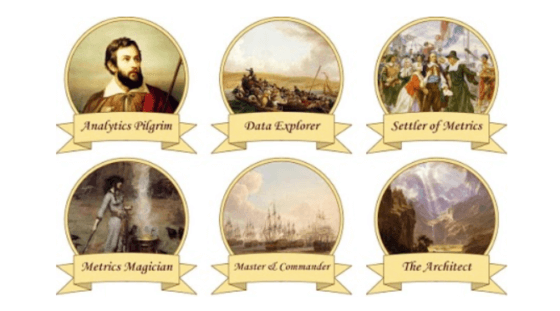Analytics the mythology
The term “analytics” has become pervasive in the nonprofit sector, as in other sectors. It appears in most conferences, strategic plans, grant applications, and requests for proposal. It is used so often and in so many contexts that people have come to gloss over what they actually mean when they say it, or what it means to “use” analytics, and to use it well.
At this point “analytics” has reached a mythological status as the omnipotent source of marketing efficiency and the panacea for all that ails an underperforming communications department. At the same time, however, it is also seen as unattainably complex by many organizations, causing them to settle for out-of-the-box simplicity and to never realize the full promise of the data they already have access to.
Well there is truth in every legend, and analytics does indeed bring great power to any organization that uses it effectively, but figuring out exactly how to integrate it appropriately with your organization is the step that often gets glossed over.
Analytics the management philosophy
There are really two sides to analytics: analytics the technical discipline, and analytics the management philosophy. Much has been done and even more has been written on analytics the technical discipline—the proper collection and analysis of data—so today we’re going to focus on the flip side of that coin, which is the incorporation of analytics into your corporate culture and business processes.
The Center for Advanced Research on Language Acquisition defines culture as “the shared patterns of behaviors and interactions, cognitive constructs, and affective understanding that are learned through a process of socialization.” In order to become a data-driven organization, you have to adjust how your organization’s decisions, understandings, and even its language refer to analytics. Your data can’t help you until you figure out how to let it drive marketing decisions, which means we first must consider how those decisions are made. Unless you are at Google or perhaps some smaller startup that lets artificial intelligence run the company, your decisions are made by your staff, so that’s where analytics can have the greatest impact, and where increasing the cultural literacy around analytics will be the most profound.
A successful adoption of analytics culture recognizes the people in your organization and focuses on what motivates them to do their best work as much as it focuses on the measureable outcomes of that work. This is why we at ParsonsTKO spend time getting to know a client’s team and internal structure before we recommend frameworks for reporting on their metrics that will fit with their organizational culture. It is critical to understand what a communications team is trying to accomplish, how they go about it, and how they share their goals and challenges internally so you can support them not just with data but with analysis that speaks to leaders within their organization.
Lead by analytics
There are lots of way to lead… you can lead by the hand, lead by the nose… usually we hear “lead by example.” In management, however, leading by example often means a department head using just one or two case studies to guide tactical decision-making, which can lead to an over-reliance on commonly held wisdom, and worse: micromanagement.
Democratize your data by connecting it to your management plans, letting the lessons you learn from analysis guide your marketing team’s day-to-day decision making, and creating a feedback loop where the model of “the right thing to do” is constantly updated by the real-time metrics of your messaging. In other words: Lead by analytics.
Analytics helps you provide a single point of truth about your communications performance. Based on this shared understanding of what happened (and what is happening now) in your outreach, you can kick off discussions about digital strategy with everyone on the same page. Bringing this data to bear on a regular basis will help create an enduring culture of transparency and honest appraisal of performance that rewards innovation and lets your organization respond quickly to changing circumstances.
Here are some things you can do to help create a culture of analytics among your communications managers and staff:
- Define your metrics: Select the key performance indicators that matter to the organization as a whole, but also to each staff member individually. Bear in mind that these measures will affect how your team makes their decisions, so choose carefully!
- Report regularly: Incorporate analytics reporting into your routine management practices. Reviewing a recent marketing campaign? Base it on the key traffic drivers! Have a daily stand-up meeting? Mention what content has been getting attention! The data that you track can’t help you unless you keep it in mind as you make decisions.
- Recognize success: Use every opportunity to recognize outreach that has performed well, and challenge your staff to take lessons from it. Ask why fans responded well to your best performing post, or invite a presentation on the promotional strategy of a successful campaign. Use positive reinforcement to make analytics something your organization embraces, rather than hides from.
- Set targets: When starting a new outreach effort, consider your benchmarks (either industry standards or—more often—your own past performance) and set goals for what you hope to accomplish. Depending on your circumstances this can be a measure of outcome (people reached or converted) or a measure of effort (pieces published, tweets tweeted). There is uncertainty in marketing, which makes this an intimidating task, but it can play an important part in motivating success… It’s hard to hit a target you haven’t set!
How ParsonsTKO can help create a culture of analytics
We understand analytics inside and out, both as the technicians who can bolster your data collection, storage, and reporting, and as communications practitioners who can design an analytics framework to empower your staff to be creative and nimble in a changing landscape. Contact us if you’re setting out to introduce analytics to your organization in new ways, or if it’s time to shake up and improve an existing analytics architecture.
We already support a number of organizations, individually as clients and also as a community through presentations at conferences. At the Nonprofit Technology Conference this past March we discussed the issue of how to pick the right metrics for your organization based on your internal management structure and needs, rather than based on your technology. As a bonus, we created a fun little quiz for our audience that explores the current complexity of your analytics practices, and you can try your hand at it too by following the link below!






